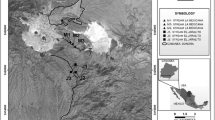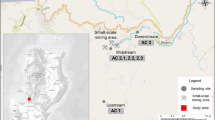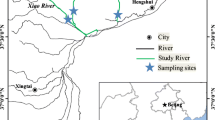Abstract
The fast-flowing and highly turbid Lagaip River (0.5–10 g/L suspended solids) in the central highlands of Papua New Guinea receives mine-derived metal inputs in both dissolved and particulate forms. Nearest the mine, metal concentrations in suspended solids were 360, 9, 90, 740 and 1,300 mg/kg for As, Cd, Cu, Pb and Zn, while dissolved concentrations were 2.7, 0.6, 3.1, 0.1 and 25 μg/L, respectively. This creates a significant metal exposure source for organisms nearer the mine. However, because the Lagaip River is diluted by a large number of tributaries, the extent to which mine-derived metals may affect biota in the lower catchments is uncertain. To improve our understanding of the forms of potentially bioavailable metals entering the lower river system, we studied the partitioning and speciation of metals within the Lagaip River system. Dissolved and particulate metal concentrations decreased rapidly downstream of the mine due to dilution from tributaries. As a portion of the particulate metal concentrations, the more labile dilute acid-extractable forms typically comprised 10–30 % for As and Pb, 50–75 % for Cu and Zn, and 50–100 % for Cd. Only dissolved Cd, Cu and Zn remained elevated relative to the non-mine-impacted tributaries (<0.03, 0.5 and 0.3 μg/L), but the concentrations did not appreciably change with increasing dilution downriver. This indicated that release of Cd, Cu and Zn was likely occurring from the more labile metal phases of the mine-derived particulates. Chelex-labile metal analyses and speciation modelling indicated that dissolved copper and lead were largely non-labile and likely complexed by naturally occurring organic ligands, while dissolved cadmium and zinc were predominantly present in labile forms. The study confirmed that mine-derived particulates may represent a significant source of dissolved metals in the lower river system; however, comparison with water quality guidelines indicates the low concentrations would not adversely affect aquatic life.



Similar content being viewed by others
References
Alberts J, Giesy J, Evans D (1984) Distribution of dissolved organic carbon and metal-binding capacity among ultrafilterable fractions isolated from selected surface waters of the southeastern United States. Environ Geol 6(2):91–101
Alin SR, Aalto R, Goni MA, Richey JE, Dietrich WE (2008) Biogeochemical characterization of carbon sources in the strickland and fly rivers, Papua New Guinea. Journal of Geophysical Research-Earth Surface 113 (F1). doi: 10.1029/2006JF000625
Allen HE (2000) Importance of clean techniques and speciation in assessing water quality for metals. Hum Ecol Risk Assess 6(6):989–1002
APHA, AWWA, WEF (2005) Standard methods for the examination of water and wastewater, 21st Ed. American Public Health Association (APHA), American Water Works Association (AWWA) & Water Environment Federation (WEF).
Audry S, Blanc G, Schafer J (2006) Solid state partitioning of trace metals in suspended particulate matter from a river system affected by smelting-waste drainage. Sci Total Environ 363(1–3):216–236
Bacon JR, Davidson CM (2008) Is there a future for sequential chemical extraction? Analyst 133(1):25–46
Bermond A, Varrault G, Sappin-Didier V, Mench M (2005) A kinetic approach to predict soil trace metal bioavailability: preliminary results. Plant Soil 275(1–2):21–29
Bowles KC, Apte SC, Batley GE, Hales HT, Rogers NJ (2006) A rapid Chelex column method for the determination of metal speciation in natural waters. Anal Chim Acta 558:237–245
Bradac P, Behra R, Sigg L (2009) Accumulation of cadmium in periphyton under various freshwater speciation conditions. Environ Sci Technol 43(19):7291–7296
Chen Z, Mayer LM (1998) Mechanisms of Cu solubilization during deposit feeding. Environ Sci Technol 32(6):770–775
Chen Z, Mayer LM (1999) Sedimentary metal bioavailability determined by the digestive constraints of marine deposit feeders: gut retention time and dissolved amino acids. Mar Ecol Prog Ser 176:139–151
Cresswell T, Smith REW, Simpson SL (2013) Challenges in understanding the sources of bioaccumulated metals in biota inhabiting turbid river systems. Environ Sci Pollut Res. doi:10.1007/s11356-013-2086-y
Croteau MN, Luoma SN (2008) A biodynamic understanding of dietborne metal uptake by a freshwater invertebrate. Environ Sci Technol 42(5):1801–1806
Croteau MN, Luoma SN (2009) Predicting dietborne metal toxicity from metal influxes. Environ Sci Technol 43(13):4915–4921
ECP (2000) Environmental code of practice for the mining industry. Papua New Guinea Office of Environment and Conservation, Port Moresby
Fleming AW, Handley GA, Williams KL, Hills AL, Corbett GJ (1986) The Porgera gold deposit, Papua New Guinea. Econ Geol 81(3):660–680
Lacal J, da Silva MP, García R, Sevilla MT, Procopio JR, Hernández L (2003) Study of fractionation and potential mobility of metal in sludge from pyrite mining and affected river sediments: changes in mobility over time and use of artificial ageing as a tool in environmental impact assessment. Environ Pollut 124(2):291–305
Li N, Zhao YL, Yang J (2008) Effects of water-borne copper on digestive and metabolic enzymes of the giant freshwater prawn Macrobrachium rosenbergii. Arch Environ Contam Toxicol 55(1):86–93
Linge KL (2008) Methods for investigating trace element binding in sediments. Crit RevEnv Sci Technol 38(3):165–196
Luoma SN, Rainbow PS (2008) Metal contamination in aquatic environments: science and lateral management. Cambridge University Press, Cambridge
Paquin PR, Gorsuch JW, Apte S, Batley GE, Bowles KC, Campbell PGC, Delos CG, Di Toro DM, Dwyer RL, Galvez F, Gensemer RW, Goss GG, Hogstrand C, Janssen CR, McGeer JC, Naddy RB, Playle RC, Santore RC, Schneider U, Stubblefield WA, Wood CM, Wu KB (2002) The biotic ligand model: a historical overview. Comparative Biochemistry and Physiology Part C. Toxicol Pharmacol 133(1–2):3–35
PJV (2011) Porgera Joint Venture Environmental Monitoring: January–December 2010. 2010 Annual Report. Porgera Joint Venture. http://www.barrick.com/Theme/Barrick/files/porgera/2010-Porgera-Annual-Environment-Report.pdf. Accessed 21 Feb 2012
Rainbow PS (2002) Trace metal concentrations in aquatic invertebrates: why and so what? Environ Pollut 120(3):497–507
Richards JP, Bray CJ, Channer DMD, Spooner ETC (1997) Fluid chemistry and processes at the Porgera gold deposit, Papua New Guinea. Miner Deposita 32(2):119–132
Robbins GH (1996) Historical development of the INCO SO2/AIR cyanide destruction process. Cim Bulletin 89(1003):63–69
Santore RC, Di Toro DM, Paquin PR, Allen HE, Meyer JS (2001) Biotic ligand model of the acute toxicity of metals. 2. Application to acute copper toxicity in freshwater fish and Daphnia. Environ Toxicol Chem 20(10):2397–2402
Simpson SL, Apte SC, Davies CM (2005) Bacterially assisted oxidation of copper sulfide minerals in tropical river waters. Environ Chem 2(1):49–55
Snape I, Scouller RC, Stark SC, Stark J, Riddle MJ, Gore DB (2004) Characterisation of the dilute HCl extraction method for the identification of metal contamination in Antarctic marine sediments. Chemosphere 57(6):491–504
Tipping E (1994) WHAM—a chemical-equilibrium model and computer code for waters, sediments, and soils incorporating a discrete site electrostatic model of ion-binding by humic substances. Comput Geosci 20(6):973–1023
Tipping E, Lofts S, Lawlor AJ (1998) Modelling the chemical speciation of trace metals in the surface waters of the Humber system. Sci Total Environ 210(1–6):63–77
Turner A (2006) Enzymatic mobilisation of trace metals from estuarine sediment. Mar Chem 98(2–4):140–147
Turner A, Henon DN, Dale JLL (2001) Pepsin-digestibility of contaminated estuarine sediments. Estuar Coast Shelf Sci 53(5):671–681
Turner A, Olsen YS (2000) Chemical versus enzymatic digestion of contaminated estuarine sediment: relative importance of iron and manganese oxides in controlling trace metal bioavailability. Estuar Coast Shelf Sci 51(6):717–728
Vasile GG, Tanase IG (2008) Comparative study of different extraction methods for evaluation of bioavailability of terrestrial sediment—bound metallic elements. Rev Roum Chim 53(11):1041–1049
Xue H, Kistler D, Sigg L (1995) Competition of copper and zinc for strong ligands in a eutrophic lake. Limnol Oceanogr 40(6):1142–1152
Acknowledgments
This work was primarily funded by Porgera Joint Venture, who also provided logistical support for the fieldwork. The authors would especially like to thank Paulus Bak, Riall Gabuogi and Charlie Ross from the PJV Environment Department for their continued support. The study was also funded by an Endeavour International Postgraduate Research Scholarship and a CSIRO Top-Up scholarship awarded to Tom Cresswell. The authors would like to thank Dr. Graeme Batley, Dr. Brad Angel and Dr. Lisa Golding for editorial assistance with this manuscript and two anonymous reviewers for their constructive comments.
Author information
Authors and Affiliations
Corresponding author
Additional information
Responsible editor: Céline Guéguen
Electronic supplementary material
Below is the link to the electronic supplementary material.
ESM 1
(DOCX 64 kb)
Rights and permissions
About this article
Cite this article
Cresswell, T., Smith, R.E.W., Nugegoda, D. et al. Challenges with tracing the fate and speciation of mine-derived metals in turbid river systems: implications for bioavailability. Environ Sci Pollut Res 20, 7803–7814 (2013). https://doi.org/10.1007/s11356-013-2066-2
Received:
Accepted:
Published:
Issue Date:
DOI: https://doi.org/10.1007/s11356-013-2066-2




